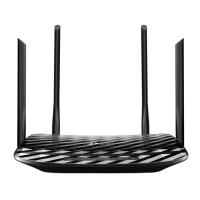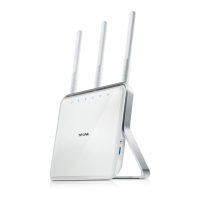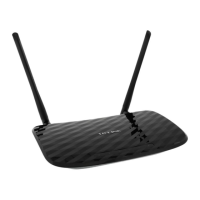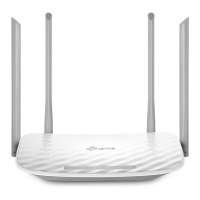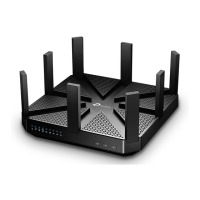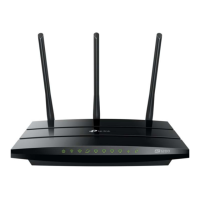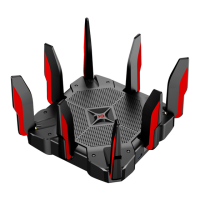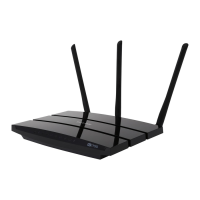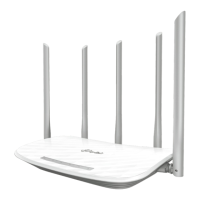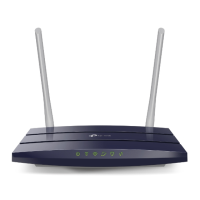Do you have a question about the TP-Link Archer C90 and is the answer not in the manual?
Explains the symbols and text formatting used in the guide.
Provides links to support, downloads, specifications, and forums.
Introduces the router's design, features, and benefits for SOHO users.
Details the physical layout of the router, including front and back panels.
Describes the LEDs on the front panel and their indications.
Describes the ports and buttons located on the rear panel of the router.
Provides guidelines for optimally placing the router for best performance and safety.
Step-by-step instructions for physically connecting the router to the modem and power.
Guides users through an automated setup process for internet connection.
Instructions for configuring internet connection settings manually via the web interface.
Details how to configure the router for IPv6 internet service.
Explains how to set up the router to extend an existing network's coverage.
Instructions for creating a TP-Link cloud account for device management.
How to modify email address and password associated with a TP-Link ID.
Managing admin and user accounts for router access via TP-Link ID.
Steps to add another TP-Link ID to manage the router as a user.
Steps to unbind TP-Link IDs that are managing the router.
How to use the TP-Link Tether mobile app to manage the router.
Steps to set up a separate Wi-Fi network for guests.
Options to control guest access, such as allowing clients to see each other.
How to connect and access USB storage devices locally or remotely.
Methods to access files on a USB drive from a Windows or Mac computer.
How to access USB files from outside the local network via FTP.
Customizing server names, sharing accounts, and specific folder access for USB devices.
Instructions for sharing media files (photos, music, videos) from USB drives.
How to block content, set time limits, and restrict internet access for devices.
How to view websites visited and time spent online by connected devices.
Configuring SPI Firewall and DoS Protection to prevent cyber threats.
Blocking or allowing specific devices to access the network using blacklists/whitelists.
Binding IP addresses to MAC addresses to prevent ARP spoofing attacks.
Setting up virtual servers to share local resources like websites or FTP servers.
Configuring port triggering for applications like online games and VoIP.
Setting up a DMZ host to allow unrestricted communication for specific applications.
Enabling UPnP for seamless network communication, especially for online gaming.
Setting up an OpenVPN server for secure remote access to the home network.
Configuration steps for enabling OpenVPN server on the router.
Steps to set up an OpenVPN client for remote access.
Setting up a PPTP VPN server for remote access, noting its security limitations.
Configuration steps for enabling PPTP VPN server on the router.
Steps to set up a PPTP VPN client for remote access using Windows.
How to change the router's LAN IP address and subnet mask.
Setting up the router for IPTV services, including IGMP proxy configuration.
Configuring DHCP server settings, including IP address pools and reservations.
Configuring DDNS to access the router using a domain name.
Manually configuring routing rules for specific network destinations.
Customizing wireless network name (SSID), password, and security settings.
Using WPS for easy and secure Wi-Fi connection setup.
Managing the router's PIN for WPS connections.
Step-by-step guide for connecting devices using WPS.
Configuring the router's system time, either automatically or manually.
Turning on/off router LEDs and enabling/disabling Night Mode.
Using Ping and Traceroute tools to diagnose network connectivity issues.
Instructions for updating the router's firmware via online or manual methods.
Backing up, restoring, and resetting router configuration settings.
Scheduling automatic reboots to improve router performance and stability.
Changing the password used to access the router's web management page.
Setting up password recovery options in case the login password is forgotten.
Managing router access from the local network, including HTTPS and device control.
Enabling and configuring remote access to manage the router from outside the network.
Saving and sending system logs for troubleshooting network issues.
Monitoring LAN, WAN, and WLAN traffic statistics for network activity.
Explains the symbols and text formatting used in the guide.
Provides links to support, downloads, specifications, and forums.
Introduces the router's design, features, and benefits for SOHO users.
Details the physical layout of the router, including front and back panels.
Describes the LEDs on the front panel and their indications.
Describes the ports and buttons located on the rear panel of the router.
Provides guidelines for optimally placing the router for best performance and safety.
Step-by-step instructions for physically connecting the router to the modem and power.
Guides users through an automated setup process for internet connection.
Instructions for configuring internet connection settings manually via the web interface.
Details how to configure the router for IPv6 internet service.
Explains how to set up the router to extend an existing network's coverage.
Instructions for creating a TP-Link cloud account for device management.
How to modify email address and password associated with a TP-Link ID.
Managing admin and user accounts for router access via TP-Link ID.
Steps to add another TP-Link ID to manage the router as a user.
Steps to unbind TP-Link IDs that are managing the router.
How to use the TP-Link Tether mobile app to manage the router.
Steps to set up a separate Wi-Fi network for guests.
Options to control guest access, such as allowing clients to see each other.
How to connect and access USB storage devices locally or remotely.
Methods to access files on a USB drive from a Windows or Mac computer.
How to access USB files from outside the local network via FTP.
Customizing server names, sharing accounts, and specific folder access for USB devices.
Instructions for sharing media files (photos, music, videos) from USB drives.
How to block content, set time limits, and restrict internet access for devices.
How to view websites visited and time spent online by connected devices.
Configuring SPI Firewall and DoS Protection to prevent cyber threats.
Blocking or allowing specific devices to access the network using blacklists/whitelists.
Binding IP addresses to MAC addresses to prevent ARP spoofing attacks.
Setting up virtual servers to share local resources like websites or FTP servers.
Configuring port triggering for applications like online games and VoIP.
Setting up a DMZ host to allow unrestricted communication for specific applications.
Enabling UPnP for seamless network communication, especially for online gaming.
Setting up an OpenVPN server for secure remote access to the home network.
Configuration steps for enabling OpenVPN server on the router.
Steps to set up an OpenVPN client for remote access.
Setting up a PPTP VPN server for remote access, noting its security limitations.
Configuration steps for enabling PPTP VPN server on the router.
Steps to set up a PPTP VPN client for remote access using Windows.
How to change the router's LAN IP address and subnet mask.
Setting up the router for IPTV services, including IGMP proxy configuration.
Configuring DHCP server settings, including IP address pools and reservations.
Configuring DDNS to access the router using a domain name.
Manually configuring routing rules for specific network destinations.
Customizing wireless network name (SSID), password, and security settings.
Using WPS for easy and secure Wi-Fi connection setup.
Managing the router's PIN for WPS connections.
Step-by-step guide for connecting devices using WPS.
Configuring the router's system time, either automatically or manually.
Turning on/off router LEDs and enabling/disabling Night Mode.
Using Ping and Traceroute tools to diagnose network connectivity issues.
Instructions for updating the router's firmware via online or manual methods.
Backing up, restoring, and resetting router configuration settings.
Scheduling automatic reboots to improve router performance and stability.
Changing the password used to access the router's web management page.
Setting up password recovery options in case the login password is forgotten.
Managing router access from the local network, including HTTPS and device control.
Enabling and configuring remote access to manage the router from outside the network.
Saving and sending system logs for troubleshooting network issues.
Monitoring LAN, WAN, and WLAN traffic statistics for network activity.
| Color | black |
|---|---|
| Wi-Fi Speed | 1900 megabits per second |
| Band Technology | dual |
| Frequency Band | 2.4 ghz, 5.0 ghz |
| QoS Traffic Prioritization | yes |
| Ethernet Standard | 10/100/1000 |
| Ethernet Switch | yes |
| Wireless Networking Standard | wi-fi 5 |
| Wireless Standard | ac, n |
| 2.4 Ghz Streams | 1 |
| 5.0 Ghz Streams | 1 |
| Gigabit Ethernet Speed | yes |
| Antennas | 4 |
| Parental Control | yes |
| Firewall | spi |
| Data Encryption | yes |
| Encryption Type | wpa, wpa2, wpa-psk, wpa2-psk |
| Ports | rj-45, usb |
| LAN Ports | 4 |
| WAN Ports | 1 |
| Built In Modem | yes |
| Height | 1.3 inches |
|---|---|
| Width | 9.6 inches |
| Net Weight | 1.2 pounds |

